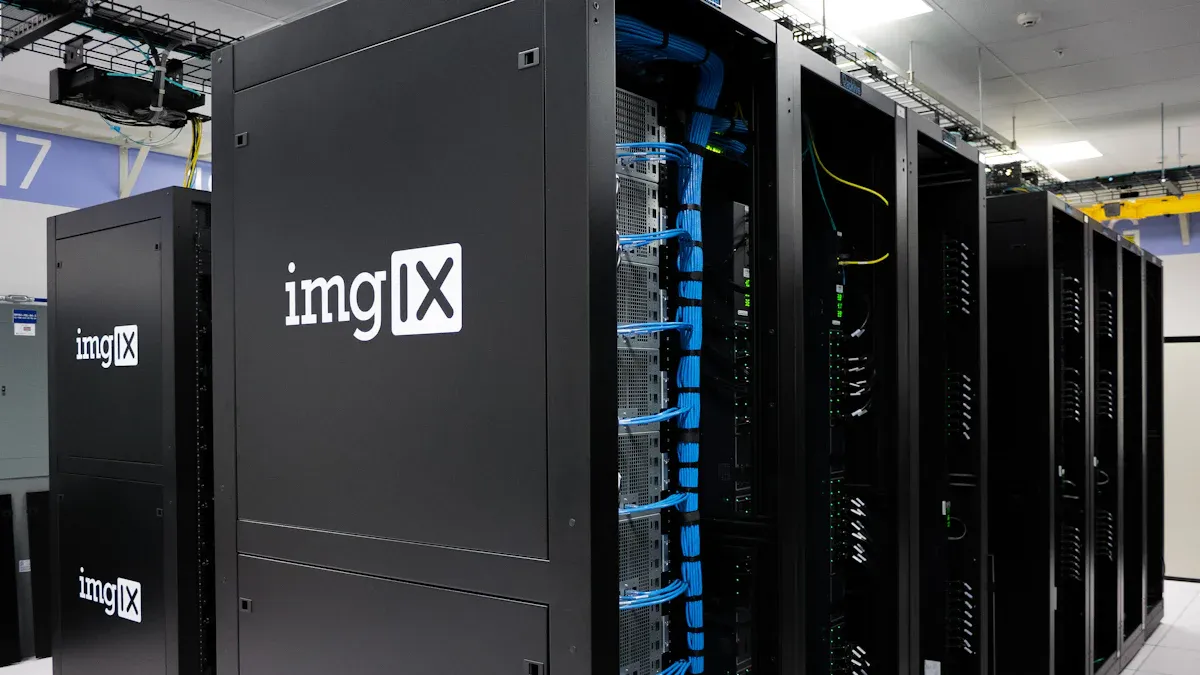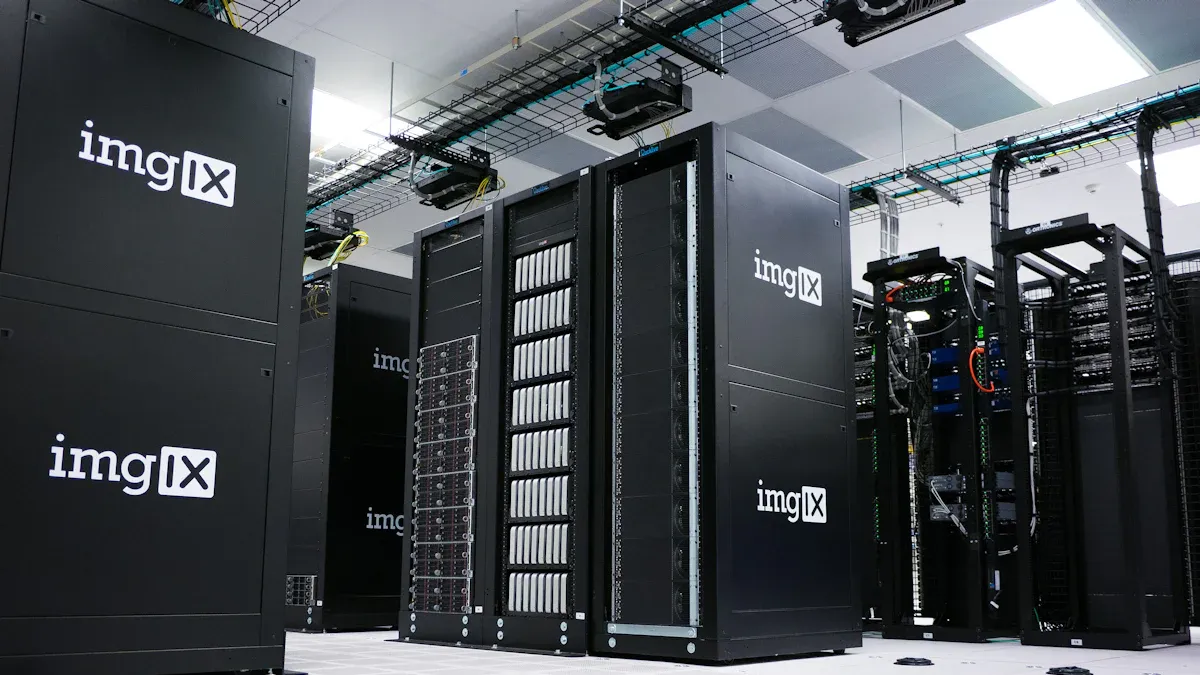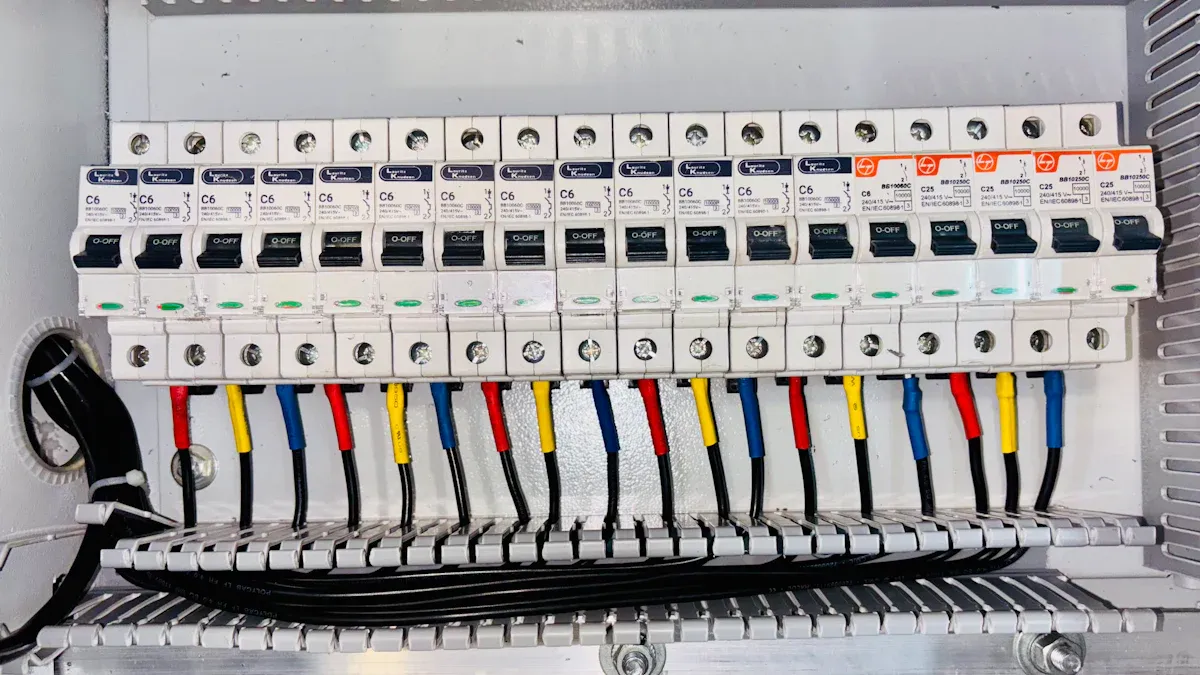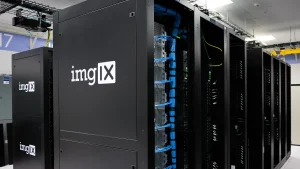
Discover the top 5 Basic PDUs for reliable power distribution in 2025. These essential devices ensure stable power delivery to critical equipment. Understand the key features that make these units stand out. Learn how to select the perfect model for your specific requirements. This guide helps users make informed decisions. An Intelligent PDU offers advanced monitoring capabilities, but a Basic PDU provides foundational power without the added complexity.
Key Takeaways
- Basic PDUs give power to many devices in a rack. They are simple and reliable.
- Look at power needs, outlet types, and mounting options. This helps you pick the right PDU.
- Good Basic PDUs have strong parts and safety approvals. This makes them last long.
- Basic PDUs do not have smart features. They just give power.
- Match the PDU’s power to your devices. This stops power problems.
- Many brands make Basic PDUs. They offer different choices for your needs.
Key Takeaways for Basic PDU Selection
Essential Basic PDU Features at a Glance
A Basic PDU provides fundamental power distribution. It delivers reliable power to multiple devices within a rack or enclosure. Key features include various outlet types. These often consist of NEMA or IEC outlets, matching different equipment power cords. The input plug type also varies, depending on the power source available. Amperage and voltage ratings define the total power capacity a PDU can handle. Users must match these ratings to their equipment’s requirements. Many Basic PDUs incorporate circuit breakers. These breakers protect connected devices from overloads. Mounting options are crucial for installation flexibility. They include horizontal rack-mount, vertical rack-mount, and even zero-U options. Durable construction materials ensure long-term reliability in demanding environments.
Top Considerations for Your Next Basic PDU Purchase
Selecting the right Basic PDU requires careful evaluation of several factors. First, assess the capacity and power requirements. Determine the total amperage and voltage your equipment needs. This ensures the PDU can safely supply power without tripping breakers. Second, consider the outlet types and quantity. Match the PDU’s outlets to the plugs on your servers, switches, and other devices. Ensure the PDU offers enough outlets for current and future expansion. Third, evaluate mounting options. Rack space is often limited. Choose a PDU that fits your rack’s available space, whether horizontally or vertically. Fourth, prioritize build quality and durability. A robust PDU withstands continuous operation and provides consistent power. Look for units with sturdy metal housings and appropriate safety certifications. Finally, consider your budget. Basic PDUs offer cost-effective power distribution. Balance the initial cost with the features and reliability required for your critical infrastructure.
Quick Comparison Table of Recommended Basic PDUs
Basic PDU Model Overview
Selecting the ideal power distribution unit begins with understanding the available models. Manufacturers offer a wide array of Basic PDU options, each designed for specific environments and power needs. These units vary significantly in their form factors, such as horizontal rack-mount, vertical rack-mount, and zero-U designs. They also differ in their overall power capacity. For example, APC Basic Rack PDUs provide power configurations ranging from 5kW up to 34.6kW. A specific Tripp Lite PDUH32HV model, a basic PDU, offers a power capacity of 7.7kW. It operates on a single-phase 200-240V power distribution and includes 10 C13 outlets. Other APC models include an 11 kW, 230V Zero U unit and a 3.7kW, 230V, 16A 1U unit. This diversity ensures users find a model that precisely fits their infrastructure.
Key Specifications Comparison for Basic PDUs
Users compare Basic PDUs based on several critical specifications. Power capacity stands as a primary differentiator, encompassing amperage, voltage, and total wattage. Outlet types and quantity are equally important. Basic PDU models are available with either IEC or NEMA outlet configurations. A specific model, for instance, offers 12 AC outlets in either IEC or NEMA socket configurations, such as (12) NEMA 5-15R or (12) IEC 320 C13. Data centers commonly use C-13 and C-19 connectors. C-13 connectors typically serve servers and small switches. C-19 plugs handle blades and larger networking equipment due to their higher current carrying capacity. Common outlet configurations for basic horizontal PDUs also include UK 13 Amp, IEC C14, IEC C20, 16 Amp Commando, 32 Amp Commando, and Schuko. Specific PDU models are available with IEC C13 and IEC C19 sockets. Input plug type, the presence of circuit breakers, and various mounting options further distinguish these units.
Our Top 5 Recommended Basic PDUs for 2025

Basic PDU 1: The Reliable Workhorse (e.g., Tripp Lite PDUMH20HV)
Overview
The Tripp Lite PDUMH20HV stands as a robust power distribution unit designed for demanding IT environments. It provides reliable power to multiple devices within a server rack or cabinet. This unit ensures consistent power delivery, which is crucial for maintaining uptime in data centers and network closets. Its design focuses on durability and straightforward functionality.
Main Features
This PDU typically features a high-voltage input, often 200-240V, suitable for international or high-power applications. It includes multiple IEC C13 and C19 outlets, accommodating a wide range of server and networking equipment. The unit often comes with a sturdy metal housing, ensuring long-term performance. Integrated circuit breakers protect connected equipment from overloads, enhancing safety and reliability.
Pros
- High Power Capacity: It handles significant power loads, supporting numerous high-density devices.
- Durable Construction: The robust build quality ensures longevity and consistent operation in harsh environments.
- Overload Protection: Built-in circuit breakers prevent damage from power surges or excessive current draw.
- Versatile Outlets: Multiple IEC outlets offer compatibility with various IT equipment.
Cons
- Lack of Monitoring: As a basic PDU, it does not offer advanced features like remote monitoring or individual outlet control.
- Limited Public Feedback: The Tripp Lite PDUMH20HV currently shows no customer reviews or ratings available. This means users cannot easily find direct feedback on its performance from other buyers. A similar model, the Tripp Lite PDUMH20ATNET, received a 4-star rating from one reviewer who praised the PDU itself but noted issues with its network card and software.
- Higher Cost: Its robust design and high capacity can result in a higher initial investment compared to simpler models.
Ideal Use Cases
This PDU is ideal for data centers, server rooms, and enterprise-level network installations requiring dependable power distribution for high-density equipment. It suits environments where advanced power monitoring is handled by other systems or not a primary requirement.
Basic PDU 2: The Space-Saving Basic PDU (e.g., NBYOSUN Switch 13A Output PDU 6 Port)
Overview
The NBYOSUN Switch 13A Output PDU 6 Port offers a compact and efficient solution for power distribution in space-constrained environments. This unit provides essential power to a limited number of devices without occupying excessive rack space. Its design prioritizes efficiency and ease of integration into smaller setups.
Main Features
This PDU typically features a lower port count, often six outlets, making it suitable for smaller racks or specific equipment clusters. It usually includes a standard input plug, such as a UK 13A plug, for easy connection to common power sources. The compact form factor allows for flexible mounting options, including horizontal 1U rackmount or even under-desk placement. A simple on/off switch provides basic power control for the entire unit.
Pros
- Compact Design: Its small footprint saves valuable rack space.
- Cost-Effective: This unit offers an economical solution for basic power needs.
- Simple Operation: A straightforward design with an on/off switch makes it easy to use.
- Easy Installation: Its light weight and standard connections simplify setup.
Cons
- Limited Outlets: The low port count restricts the number of devices it can power.
- Lower Power Capacity: It handles less power compared to larger, more robust PDUs.
- No Advanced Features: This PDU lacks monitoring, surge protection, or individual outlet control.
- Specific Plug Type: The 13A UK plug limits its use to regions with compatible outlets.
Ideal Use Cases
This PDU is perfect for small office/home office (SOHO) setups, small network cabinets, audio/video racks, or any application where space is at a premium and only a few devices require power. It serves well for basic power distribution without complex requirements.
Basic PDU 3: The Budget-Friendly Basic PDU (e.g., CPS1215RM Basic PDU)
Overview
The CPS1215RM Basic PDU provides an economical yet reliable power distribution solution for various IT and industrial applications. This unit focuses on delivering essential power functionality at an accessible price point. It offers a practical choice for users seeking dependable power without advanced features.
Main Features
The CPS1215RM model comes with specific technical specifications designed for common rack environments.
| Specification | Value |
|---|---|
| Amperage | 15A |
| Outlets | 10 x NEMA 5-15R |
| VA Rating | 1800VA |
| Form Factor | 1U 19 Rack-mountable |
| Product Type | Rackmount PDU |
| Model | CPS-1215RM |
It features 10 NEMA 5-15R outlets, suitable for standard North American equipment. The 1U 19-inch rack-mountable form factor ensures easy integration into existing rack setups. A 15A capacity and 1800VA rating provide sufficient power for many small to medium-sized deployments.
Pros
- Affordable Price: This PDU offers excellent value for its features.
- Standard Outlets: NEMA 5-15R outlets ensure broad compatibility with common devices.
- Rack-Mountable: The 1U form factor fits easily into standard server racks.
- Reliable Power: It delivers consistent power distribution for essential equipment.
Cons
- No Advanced Features: It lacks power monitoring, remote management, or surge suppression.
- Limited Capacity: The 15A rating may not suffice for very high-density or power-hungry equipment.
- Basic Functionality: Users should not expect anything beyond fundamental power distribution.
Ideal Use Cases
This PDU is ideal for small to medium-sized businesses, educational institutions, or home labs where budget constraints are a factor. It suits applications requiring reliable power for servers, switches, and other rack-mounted equipment without the need for complex power management.
Basic PDU 4: The High-Density Basic PDU (e.g., APC AP7900)
Overview
The APC AP7900 offers a high-density power distribution solution. It provides reliable power for numerous devices in a compact form factor. This unit helps manage power efficiently within server racks. Its design focuses on delivering consistent power to critical IT equipment.
Main Features
The APC AP7900 comes with specific technical specifications. These features make it suitable for demanding environments.
| Category | Specification |
|---|---|
| Features | |
| Rack-Mountable | 19 inch, supplies redundant AC power, automatic switch to alternate power source |
| Flash Upgradeable | Firmware via network download (networked units only) |
| Mounting | Horizontal capability |
| Power Management | Power Sequencing, Remote Current Monitoring, Remote Management Capabilities (Web, SNMP, Telnet) |
| Design | |
| Product Colour | Black |
| Features (General) | |
| Cable Length | 3.66 m |
| Certification | cUL, CSA, FCC Part 15 Class A, ICES-003, Industry Canada, METI Denan, UL 60950, UL, VCCI |
| Operational Conditions | |
| Operating Relative Humidity | 0 – 95% |
| Operating Temperature | -25 – 65 °C |
| Storage Relative Humidity | 0 – 95% |
| Storage Temperature | 0 – 45 °C |
| Ports & Interfaces | |
| Input Connection Type | NEMA 5-15P |
| Output Connections | (8) NEMA 5-15R |
| Power | |
| AC Input Frequency | 50 – 60 Hz |
| Load Capacity | 1440 VA |
| Max Input Current per Phase | 15 A |
| Max Total Current Draw per Phase | 15 A |
| Nominal Input Voltage | 120 V |
| Nominal Output Voltage | 120 V |
| Weight & Dimensions | |
| Dimensions (WxDxH) | 445 x 108 x 44 mm |
| Weight | 2.27 kg |
This PDU is 19-inch rack-mountable. It offers horizontal mounting capability. The unit supplies redundant AC power and automatically switches to an alternate power source. It supports firmware upgrades via network download for networked versions. Power management features include power sequencing, remote current monitoring, and remote management capabilities through Web, SNMP, and Telnet. It features a NEMA 5-15P input connection and eight NEMA 5-15R output connections. The unit handles a 1440 VA load capacity with a 15A maximum input current at 120V.
Pros
- High Density: It provides eight outlets in a compact form factor.
- Redundant Power: The unit offers automatic switching to an alternate power source, enhancing reliability.
- Remote Management (Networked Versions): Specific versions allow remote monitoring and control, improving operational efficiency.
- Robust Certifications: It holds numerous certifications, ensuring safety and compliance.
Cons
- Limited Public Feedback: Refurbtechltd.co.uk indicates no customer reviews for the APC AP7900 PDU. Similarly, eBay explicitly states "No ratings or reviews yet" for this model. This lack of public feedback makes it difficult to gauge real-world user experiences.
- Basic Functionality: As a basic PDU, it does not offer advanced features like individual outlet metering or switching found in more sophisticated units.
- Specific Outlet Type: It primarily uses NEMA 5-15R outlets, limiting its use to regions and equipment compatible with this standard.
Ideal Use Cases
This PDU is ideal for data centers, server rooms, and network closets. It suits environments needing high outlet density and reliable power for standard NEMA devices. It also benefits setups where redundant power is crucial, and remote management (for networked versions) adds value.
Basic PDU 5: The Robust Performer Basic PDU (e.g., NBYOSUN 6 C13 Basic Metered PDU)
Overview
The NBYOSUN 6 C13 Basic Metered PDU delivers robust and dependable power. It provides essential power distribution with the added benefit of local metering. This unit ensures stable power for critical equipment. Its design focuses on durability and practical power monitoring.
Main Features
This PDU features six IEC C13 outlets. These outlets are common for servers, switches, and other IT equipment. It includes a local current meter, allowing users to monitor power consumption directly at the unit. The PDU often comes in a sturdy, rack-mountable housing. It also incorporates overload protection, typically through a circuit breaker, safeguarding connected devices.
Pros
- Local Metering: The integrated meter provides immediate visibility into power consumption.
- Robust Build: Its durable construction ensures long-term reliability in demanding environments.
- Common Outlets: Six C13 outlets offer broad compatibility with standard IT gear.
- Overload Protection: Built-in circuit breakers protect against power surges and excessive current.
Cons
- No Remote Access: The metering is local only; users cannot monitor power remotely.
- Limited Outlets: Six outlets may not suffice for very high-density racks.
- Basic Functionality: It lacks advanced features like individual outlet control or environmental monitoring.
Ideal Use Cases
This PDU is perfect for small to medium server racks, network closets, or test benches. It suits environments where local power monitoring is beneficial but remote management is not a primary requirement. It also works well for setups needing reliable power for a moderate number of C13-connected devices.
How to Choose the Right Basic PDU
Selecting the correct power distribution unit is crucial for efficient and reliable infrastructure. Users must carefully evaluate several factors to ensure optimal performance.
Capacity and Power Requirements for Your Basic PDU
Amperage and Voltage Matching for Basic PDUs
Users must match the PDU’s amperage and voltage to their equipment’s needs. PDUs designed for data centers and comms rooms can have amperage ratings ranging from 100A to 800A. These units often come as single-phase or three-phase configurations. They typically use either 16 Amp or 32 Amp power cables, depending on the required load. Correctly matching these specifications prevents overloads and ensures stable power delivery.
Total Wattage Calculation for Basic PDU Sizing
Calculating the total wattage for connected devices helps size the PDU appropriately. The current average rack power density is about 15 kW/rack. A data center rack generally consumes around 7kW. During peak demands, over half of US data centers experience power densities of approximately 15kW per rack, with some even reaching over 20kW per rack. Users should sum the maximum wattage of all devices to determine the PDU’s required capacity. This calculation ensures the PDU can handle peak loads without issues.
Outlet Types and Quantity for Basic PDUs
NEMA vs. IEC Standards for Basic PDU Outlets
Different regions and equipment types use distinct outlet standards. NEMA and IEC are the most common.
| Feature | NEMA Standard | IEC Standard |
|---|---|---|
| Connectors | L5, L6, L15 (locking types common in data centers) | C13, C19 (common for IT equipment), IEC 60309 |
| Current Ratings | 15A to 60A | Typically 16A to 63A for IT equipment (standards allow up to 250A) |
Users must select a PDU with outlets compatible with their equipment’s power cords.
Number of Outlets Needed on Your Basic PDU
Consider both current and future needs when determining the number of outlets. Users should count all devices requiring power. They should also account for potential expansion. Choosing a PDU with a few extra outlets provides flexibility.
Mounting Options for Basic PDUs
Rack Mount Considerations for Basic PDUs
Most Basic PDUs are designed for standard 19-inch server racks. Users must consider the available U-space. Some PDUs occupy 1U or 2U of horizontal space. Others offer zero-U mounting, which saves valuable rack space.
Vertical vs. Horizontal Placement of Basic PDUs
Users can mount PDUs either vertically or horizontally. Horizontal PDUs typically fit into 1U or 2U of rack space. They are suitable for racks with limited vertical space. Vertical PDUs mount along the side of the rack. They do not consume U-space. This placement is ideal for high-density racks with many devices. Vertical mounting also often improves cable management.
Build Quality and Durability of Basic PDUs
Material Construction of Basic PDUs
Most power distribution units feature robust construction. Manufacturers often use heavy-gauge steel or aluminum. These materials provide excellent durability. They protect internal components from physical damage. Metal housings also help dissipate heat efficiently. A powder-coated finish resists corrosion and wear. This ensures the unit maintains its integrity over time. High-quality materials prevent bending or cracking under stress. This is crucial in busy data center environments. The choice of material directly impacts the unit’s lifespan and ability to withstand harsh conditions.
Certifications and Standards for Basic PDUs
Reputable power distribution units carry important certifications. UL (Underwriters Laboratories) certification ensures electrical safety in North America. CE marking indicates compliance with European health, safety, and environmental protection standards. RoHS (Restriction of Hazardous Substances) compliance confirms the absence of certain dangerous materials. These certifications guarantee the product meets strict quality and safety benchmarks. They provide assurance of reliable operation. Users should always look for these marks. They confirm the product meets industry safety and performance requirements. Adherence to these standards also signifies a manufacturer’s commitment to product quality and user safety.
Budget Considerations for Your Basic PDU
Cost vs. Features in Basic PDUs
A Basic PDU offers a cost-effective solution for power distribution. It provides essential functionality without the higher price tag of intelligent or metered units. The cost typically depends on the number of outlets, amperage rating, and build quality. Users can find a suitable unit that meets their core needs without overspending. Comparing models from different manufacturers helps identify the best value. Consider the initial purchase price against the features offered. Sometimes, a slightly higher upfront cost for better build quality saves money later.
Long-Term Value of a Basic PDU
Investing in a high-quality power distribution unit offers significant long-term value. A durable unit reduces the need for frequent replacements. Its reliable performance prevents power interruptions. This protects valuable IT equipment from damage. Consistent power delivery minimizes downtime, which saves operational costs. A well-chosen power distribution unit contributes to the overall stability and efficiency of an IT infrastructure. It also reduces maintenance efforts over its lifespan. This long-term perspective often outweighs the appeal of the cheapest option.
Understanding Basic PDU Terminology and Components

What Exactly is a Basic PDU?
A Basic PDU provides reliable power distribution for essential IT equipment in racks or cabinets. These cost-effective, entry-level solutions offer various electrical and socket configurations. They deliver a straightforward method for powering IT infrastructure without additional monitoring or control features. A basic PDU resembles a standard extension lead. It features multiple power sockets within a self-contained housing, an input power lead, and a plug. Its primary function involves simple power outlet connection and distribution. These PDUs can connect to a mains power supply or a UPS outlet. They may be unswitched, individually switched, or individually fused. Some also include surge and filter protection, as well as overload breakers. Basic PDUs are ideal for small computer and server rooms or remote racks with limited power requirements.
Key Components of a Basic PDU Explained
A Basic PDU contains several important internal components. A double pole 100A isolator serves as the connection point for the main incoming power feed. This device is often lockable. Type 1, 2, and 3 surge protection reduces voltage spikes. This protects internal rack-mounted equipment from damage. Some PDUs include 6A RCBOs. These individually protect each IEC C13 kettle lead. They also protect 13A socket bars and spare connections for communications equipment. Other units may feature Type C 6A MCBs if a fan kit is necessary. These components ensure safe and reliable power delivery. WAGO Topjob terminal blocks ease the installation of incoming and outgoing cables.
Common Misconceptions About Basic PDUs
Many people misunderstand the capabilities of Basic PDUs. A common misconception is that they offer advanced power monitoring or remote control. Basic PDUs do not provide these features. They focus solely on distributing power. Users often confuse them with intelligent or metered PDUs. Those units include sensors for current, voltage, and temperature. Another misconception involves power conditioning. Basic PDUs typically do not actively condition power. They may include surge protection, but they do not regulate voltage or filter noise like a UPS or dedicated power conditioner. Their role is simple: deliver power from a source to multiple devices.
Leading Basic PDU Brands and Their Offerings
Many reputable manufacturers offer reliable power distribution units. These brands provide solutions for various IT environments. They focus on quality and performance.
APC Basic PDU Solutions
APC, a well-known name in power protection, offers a range of Basic PDU solutions. These units provide dependable power distribution for servers and networking equipment. APC’s Basic PDUs come in different configurations. They suit various rack sizes and power requirements. For example, APC offers models like the AP9565 and AP9559. They also provide the AP6020A. These models ensure essential power delivery without advanced features.
| Company | Basic PDU Product Line/Model |
|---|---|
| APC | AP9565 |
| APC | AP9559 |
| APC | AP6020A |
APC Basic PDUs are known for their robust construction. They offer easy installation. Users can find units with various outlet types, including NEMA and IEC. This ensures compatibility with diverse equipment.
Tripp Lite Basic PDU Solutions
Tripp Lite specializes in power and connectivity solutions. They offer a comprehensive line of Basic PDUs. These units deliver reliable power to critical IT infrastructure. Tripp Lite focuses on durability and straightforward functionality. Their Basic PDUs are suitable for data centers, server rooms, and network closets. An example of their offering is the Tripp Lite PDUH32HV. This model provides high-voltage power distribution. Tripp Lite PDUs often feature sturdy metal housings. They include built-in circuit breakers for overload protection. This protects connected devices from power surges.
| Company | Basic PDU Product Line/Model |
|---|---|
| Tripp Lite | PDUH32HV |
Tripp Lite provides various mounting options. These include horizontal and vertical rack-mount designs. This allows flexible installation in different rack environments.
CyberPower Basic PDU Solutions
CyberPower delivers reliable power management products. Their Basic PDU offerings provide essential power distribution. These units are cost-effective solutions for various applications. CyberPower Basic PDUs ensure consistent power delivery to IT equipment. They are ideal for small to medium-sized businesses and educational institutions. CyberPower focuses on user-friendly designs. Their PDUs often feature durable construction. They include multiple outlets to power several devices simultaneously. Users can find CyberPower Basic PDUs with different amperage ratings. They also offer various outlet configurations. This helps meet specific power needs.
Eaton Basic PDU Solutions
Eaton provides comprehensive power management solutions. Their Basic PDU offerings deliver reliable power distribution for various IT environments. Eaton focuses on robust construction and essential functionality. These units ensure consistent power delivery to critical equipment within server racks and cabinets. Eaton’s Basic PDUs come in diverse configurations. They include horizontal and vertical mounting options. Users can select units with different outlet types, such as NEMA and IEC. This ensures compatibility with a wide range of IT gear.
Eaton designs its Basic PDUs for durability and ease of installation. They feature sturdy metal housings. These housings protect internal components. Many models include built-in circuit breakers. These breakers offer overload protection. This safeguards connected devices from power surges. Eaton’s commitment to quality ensures long-term performance. Their solutions support data centers, network closets, and enterprise-level installations. They provide dependable power without advanced monitoring features. Eaton’s Basic PDUs offer a cost-effective way to power essential infrastructure.
Vertiv Geist Basic PDU Solutions
Vertiv Geist specializes in data center infrastructure solutions. Their Basic PDU range provides robust power distribution for critical IT loads. Vertiv Geist focuses on high-quality engineering and reliability. These units ensure stable power delivery to servers, switches, and other rack-mounted equipment. Vertiv Geist Basic PDUs feature a durable design. They withstand demanding data center environments. They offer various outlet configurations. This includes common NEMA and IEC options. This flexibility supports diverse equipment needs.
Vertiv Geist Basic PDUs are known for their straightforward functionality. They provide essential power without complex features. Users benefit from easy installation and dependable operation. Many models offer different form factors. These include horizontal and vertical mounting. This allows efficient use of rack space. Vertiv Geist integrates overload protection into its PDUs. This protects connected devices from electrical faults. Their solutions are ideal for organizations seeking reliable power distribution. They offer a foundational power solution for any IT setup.
Readers should make an informed decision for their next Basic PDU purchase. They can power up their infrastructure smartly with the right Basic PDU. Users must evaluate their specific needs to select the ideal Basic PDU from our recommendations. This ensures optimal performance and reliability for their IT equipment.
FAQ
What is a Basic PDU?
A Basic PDU distributes power to multiple devices within a rack. It provides essential power outlets without advanced features. Users connect equipment to these outlets for reliable power delivery. This unit serves as a fundamental power strip for IT infrastructure.
How does a Basic PDU differ from a Smart PDU?
A Basic PDU offers simple power distribution. It lacks monitoring or remote control capabilities. A Smart PDU includes features like power metering, remote management, and individual outlet switching. Users choose based on their specific power management needs.
Do Basic PDUs offer surge protection?
Some Basic PDUs include built-in surge protection. This feature safeguards connected equipment from power spikes. However, not all basic models offer this. Users should check product specifications for surge protection details. ⚡
How do users choose the right amperage for a Basic PDU?
Users calculate the total amperage required by all connected devices. They select a PDU with an amperage rating higher than this total. This ensures safe operation and prevents overloading. Matching the PDU’s capacity to equipment needs is crucial.
Can users use a Basic PDU for home use?
Yes, users can employ Basic PDUs in home setups. They provide organized power distribution for home servers or entertainment systems. Their straightforward functionality suits environments without complex power management requirements.
What are the common outlet types on Basic PDUs?
Common outlet types include NEMA and IEC. NEMA outlets are prevalent in North America. IEC outlets, like C13 and C19, are standard for IT equipment globally. Users select a PDU with outlets matching their device plugs.
Are Basic PDUs expensive?
Basic PDUs are generally cost-effective. Their price varies based on outlet count, amperage, and build quality. They offer an economical solution for reliable power distribution without the added cost of advanced features.



